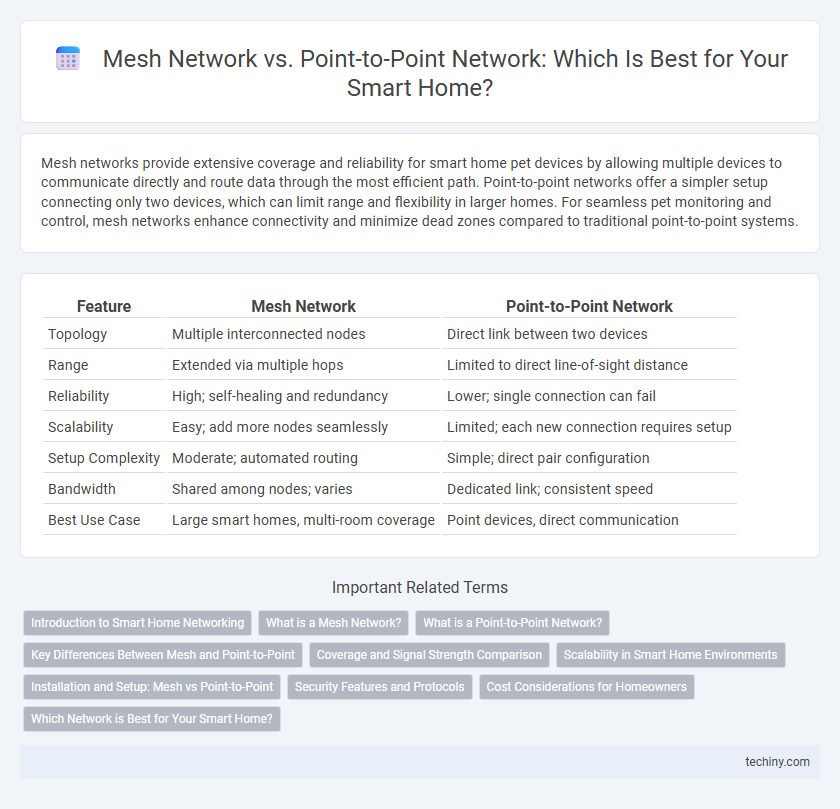Mesh networks provide extensive coverage and reliability for smart home pet devices by allowing multiple devices to communicate directly and route data through the most efficient path. Point-to-point networks offer a simpler setup connecting only two devices, which can limit range and flexibility in larger homes. For seamless pet monitoring and control, mesh networks enhance connectivity and minimize dead zones compared to traditional point-to-point systems.
Table of Comparison
| Feature | Mesh Network | Point-to-Point Network |
|---|---|---|
| Topology | Multiple interconnected nodes | Direct link between two devices |
| Range | Extended via multiple hops | Limited to direct line-of-sight distance |
| Reliability | High; self-healing and redundancy | Lower; single connection can fail |
| Scalability | Easy; add more nodes seamlessly | Limited; each new connection requires setup |
| Setup Complexity | Moderate; automated routing | Simple; direct pair configuration |
| Bandwidth | Shared among nodes; varies | Dedicated link; consistent speed |
| Best Use Case | Large smart homes, multi-room coverage | Point devices, direct communication |
Introduction to Smart Home Networking
Smart home networking relies heavily on the choice between mesh networks and point-to-point networks to optimize device communication and coverage. Mesh networks enhance connectivity through multiple interconnected nodes, providing robust signal strength and seamless device integration up to hundreds of devices within a large area. Point-to-point networks create dedicated links between two devices, offering direct, low-latency connections suitable for simple or small-scale smart home setups with limited coverage needs.
What is a Mesh Network?
A mesh network is a decentralized wireless system where devices, or nodes, interconnect directly, dynamically, and non-hierarchically to efficiently route data to and from clients. This network design enhances smart home coverage by allowing multiple paths for data transmission, reducing dead zones and improving reliability compared to traditional point-to-point setups. Mesh networks support scalability and self-healing capabilities, making them ideal for large or complex smart home environments.
What is a Point-to-Point Network?
A point-to-point network in smart home setups connects two devices directly, ensuring a dedicated communication link with minimal latency and high security. This network type is ideal for simple device pairs like smart locks and hubs, providing reliable data transfer without interference from other devices. Compared to mesh networks, point-to-point connections offer straightforward installation and consistent performance for specific device pairs.
Key Differences Between Mesh and Point-to-Point
Mesh networks create multiple interconnected nodes that provide extensive coverage and high reliability by dynamically routing data through various paths, ensuring minimal dead zones in smart home environments. Point-to-point networks establish a direct, fixed connection between two devices, offering simpler setup and lower latency but limited coverage and scalability. Mesh networks excel in large, complex smart homes requiring seamless connectivity, whereas point-to-point suits smaller setups with straightforward communication needs.
Coverage and Signal Strength Comparison
Mesh networks provide superior coverage and stronger signal strength in smart home environments by using multiple interconnected nodes that relay data, ensuring consistent connectivity throughout large or multi-story homes. Point-to-point networks rely on a direct connection between two devices, which often results in limited range and potential signal degradation due to obstacles like walls or interference. Mesh networks dynamically optimize signal paths and self-heal, maintaining high performance and reducing dead zones compared to the fixed, line-of-sight constraints of point-to-point setups.
Scalability in Smart Home Environments
Mesh networks offer superior scalability in smart home environments by allowing multiple devices to connect and communicate seamlessly over extended areas, enhancing coverage and reliability. Point-to-point networks are limited by direct connections between devices, restricting expansion and making it challenging to support numerous smart home gadgets. As smart homes grow with diverse IoT devices, mesh networking provides a flexible and robust solution that supports seamless integration and future scalability.
Installation and Setup: Mesh vs Point-to-Point
Mesh network installation involves placing multiple interconnected nodes strategically throughout the home to ensure seamless coverage and self-healing connectivity. Point-to-point network setup requires direct line-of-sight alignment between two devices, often needing precise positioning and potential adjustments for optimal signal strength. Mesh networks simplify expansion and reduce dead zones, while point-to-point setups demand careful initial calibration and are better suited for fixed, short-range connections.
Security Features and Protocols
Mesh networks in smart homes enhance security by utilizing dynamic routing protocols like Zigbee and Thread, which offer robust encryption and device authentication to prevent unauthorized access. Point-to-point networks rely on simpler protocols such as Wi-Fi or Bluetooth, often lacking advanced security layers, making them more vulnerable to interception and hacking. The decentralized architecture of mesh networks also reduces single points of failure, providing improved resilience against cyberattacks in smart home environments.
Cost Considerations for Homeowners
Mesh networks typically incur higher initial costs due to multiple nodes and advanced technology, but they offer scalable coverage that reduces the need for additional devices over time. Point-to-point networks have lower upfront expenses, relying on a direct connection between devices, but often require repeaters or additional hardware to extend range, increasing long-term costs. Homeowners should weigh upfront investment against future expansion needs and potential maintenance expenses when choosing between mesh and point-to-point smart home network setups.
Which Network is Best for Your Smart Home?
Mesh networks offer superior coverage and reliability for smart homes by allowing devices to communicate with multiple nodes, reducing dead zones and enhancing connectivity for all smart devices. Point-to-point networks provide direct, high-speed connections between two devices but can struggle with range limitations and scalability in larger homes. Opting for a mesh network ensures seamless integration and robust performance across extensive smart home ecosystems.
Mesh Network vs Point-to-Point Network Infographic

 techiny.com
techiny.com